Front Wing Endplate
Ever wondered why F1 designers go to such extraordinary lengths to refine the design of the front wings and particularly the endplates? Top teams bring something new in this area to almost every race.
When you look down into this area of the car's design, you realize that it has far more effect on the aerodynamics than the much discussed double diffuser - probably five to ten times more effect! The front wing, unlike the rear, does not just provide downforce. As it is the aerodynamic device that precedes the entire car, it is also responsible for directing airflow back towards the rest of the car. The optimal direction of this airflow is of critical importance to the overall downforce levels produced by the entire car.
Double Diffusers grab all the headlines, largely because of the legality issues arised 2009, but they are nothing like as important to an F1 car as the barely discussed "outwash" front wing.
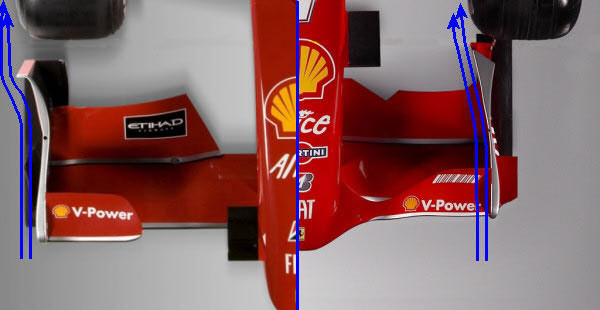 |
|
Outwash front wing after 2009 rule change |
Inwash front wing after 1998 rule change |
The front wings on the car can produce 25-40% of the cars downforce. Each front wing is made of mainplane running almost the whole width of the car suspended from the nose. Onto this are fitted two aerofoil flaps, one on each side, which are from 2009 the adjustable parts of the wing. These flaps are usually made of one piece of carbon fiber, but Ferrari has used two small flaps rather than one large one. On each end of the mainplane there are endplates.
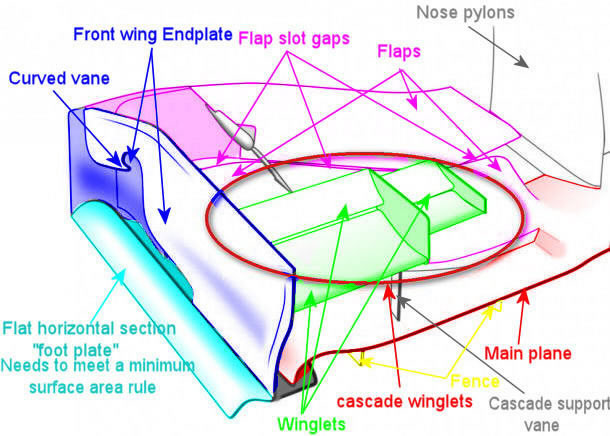
The wing flaps on either side of the nose cone are asymmetrical. They reduces in height nearer to the nose cone as this allows air to flow into the radiators and to the underfloor. If the wing flap maintained it's height right to the nose cone, the radiators would receive less airflow and therefore the engine temperature would rise. The asymmetrical shape also allows a better airflow to the underfloor and the diffuser, increasing downforce. The wing mainplane is by the FIA rules flat in the center and same design for all cars, again by the rules. This again allows a slightly better airflow to the underfloor aerodynamics, but it also reduces the wings ride height sensitivity. The main area of development is the wing profile interaction with the front wing endplate.
So, now I'm going to give the outwash wing, the spotlight it deserves.
One very important part of the front wing is the endplate design. The endplate is used to redirect the airflow around the front tyres; the tyres are certainly not designed to be aerodynamically efficient and can create a lot of drag. By directing the oncoming airflow around the front tyres, this minimises the amount of drag resistance produced and allows the airflow to continue back to the sidepods and the cars floor. The upper and main flap also helps direct airflow over the front tyres, reducing drag as well as producing airflow towards the rest of the car.
The front wing tip vortex and the front wheel wake are the most important things to control in F1 aerodynamics. You want to stop vortexes and the front wheel wake to go in places where they do too much damage. 50-60% of the aerodynamics of front wing is concentrated on this vital area.
In 1998 when F1 cars were with new rules narrowed in width from 2 metres to 1.8 metres the cars ended up with the front wing endplate alongside the inside edge of the front tire. Designers developed very sophisticated solutions to manage the front wheel wake and wing tip vortex in order to get lots of downforce.
But then in 2009 the FIA brought in a radical change of aerodynamic rules, one of which was to make the front wing wider. Now, with the tips of the front wing sitting directly ahead of the front wheels, it was a completely different story.
The more experienced engineers in the pit lane, who had been around before 1997, or who had worked on IndyCars or Le Mans cars, knew that it would be desirable to produce an outwash effect from the front wing endplate, which would generate a low pressure area on the outside of the front wheel. It would also avoid the front flap being blocked by having a wheel right behind it.
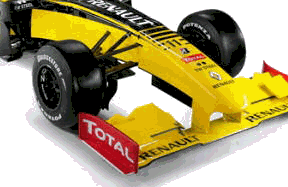
Front wing endplate on 2010 Renault R30 f1 racer on presentation of new car at beginning of 2010 season.
Over time, as the wheels were moved closer to the chassis, the front wings ends overlapped the front wheels when viewed from the front. This created unnecessary turbulence in front of the wheels, further reducing aerodynamic efficiency and thus contributing to unwanted drag.
To overcome this problem, the top teams made the inside edges of the front wing endplates curved to direct the air far from the casis and around the wheels. The primary function of endplate is to stop the high-pressure air on the top of the wing from being encouraged to roll over the end of the wing to the low-pressure air beneath, causing induced drag. Additionally, the design aim of the endplates is to discourage the "dirty" air created by the front tire from getting under the floor of the car. Further to these, some teams use 'splitters', which are vertical fences, attached to the undersurface of the front wing, to assist the endplate
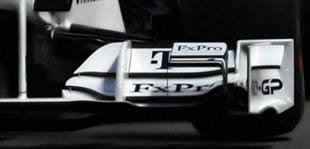 |
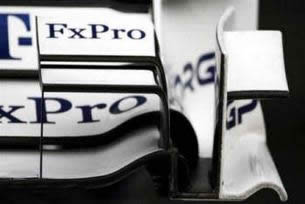 |
Front wing endplate on BMW-Sauber 2009 racer |
|
Toyota were one of the first to try it, thanks to the intervention of veteran aerodynamicist Frank Dernie, and it was one of the signature items on the Brawn car who win 2009 championship. Engineers say that the outwash front wing was the single biggest step from 2008 to 2009, far more than the double diffuser.
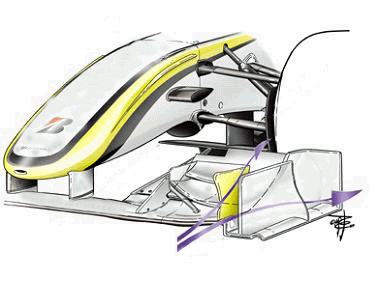
Brown BGP001 racer with highly sophisticated end plate for 2009 season
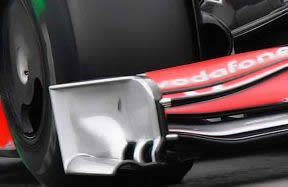
McLaren 2009 outwash wing endplate
Year 2010, every car in the pit lane has one, with varying degrees of sophistication.
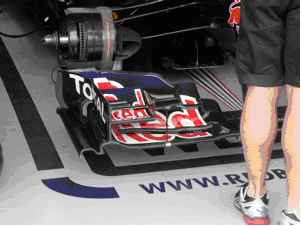
Red Bull has a very pronounced vortex channel underneath the end of the wing. If you look really closely there are lots of new details, sometimes tiny, sometimes very pronounced every race weekend, because the front wing, and particularly the tip of it, is an incredibly sensitive area and the tiniest change to a turning vane can make a big difference to the car's performance.
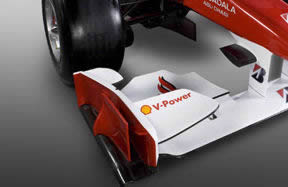
Ferrari made a good gain in Melbourne 2010 with the new wing endplate detail you can see in picture. Ferrari endplate is relatively simple but very effective. this is the proof that simple wing can be good wing.
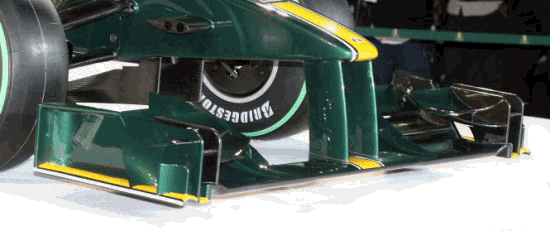
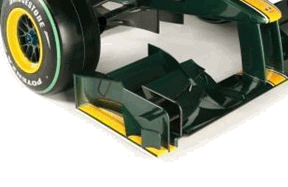
Some of the 2010 new teams like Lotus (picture left and above) HRT and Virgin have fairly crude front wings and refining them will bring a big step forward in performance, moving them closer to the midfield teams. Lotus show few important updates during the season 2010. On the end, they finished 2010 championship on 10th place, the best of new teams.
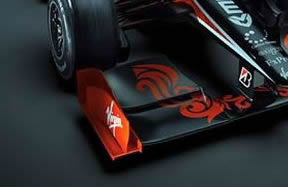
For Virgin Racing, whose designer Nick Wirth insists on using only CFD (computational fluid dynamics) in the design and development of his car, this will be a real test and the whole pit lane is watching to see how well he does it.
This is because the main weakness of CFD in F1 design is in the area of modeling front wheel wake. It is so complex and changes with every tiny movement in the attitude of the car and movement of the steering wheel. 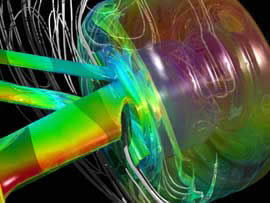
Rival engineers, who also have big CFD capability in their factories, say it's not possible to accurately measure front wheel wake using F1 standard CFD alone. This is because the air flow in the wheel wake is unsteady and the only CFD program capable of modeling unsteady flow is owned by NASA and costs $1 million a month to run!
If the rivals are right then this will hold Virgin racing back. But if Wirth comes up with a major step in this area, then the others may begin to concede that he has found an affordable way to do away with wind tunnels.
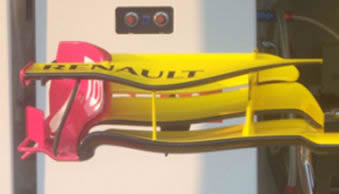 Renault showed modest pace in 2010 pre-season testing and in first race in Bahrain, but took a step forward in Australia, thanks partly to a new front wing (pictured left).
Renault showed modest pace in 2010 pre-season testing and in first race in Bahrain, but took a step forward in Australia, thanks partly to a new front wing (pictured left).
They introduced a sophisticated new outwash front wing solution and it contributed a significant amount to the car's improvement. You can see the difference from the wing endplate introduced on presentation of new car at beginning of 2010 season, picture you can see on the beginning of this article.
And in China they have come along with a further front wing update.
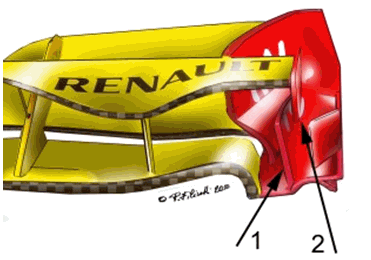
Compare this with the photo above. A lot of work has gone into the curvature of the upper front element and particularly into the detailing of the end plates. The new ones feature (1) a shorter and less vertical fin than the Melbourne wing and (2) a squarer end to the upper element.
These changes have primarily the effect of reducing the turbulence generated in this area of the car, and also reduce the front end's sensitivity to variations in the ride heights.
During season 2010, Renault brought many new parts to their car, especially front wings, from a revamped aerodynamics department. They claimed that the fully evolved R30 (race at Abu Dhabi), which did so much damage to Fernando Alonso’s championship hopes, was two seconds per lap faster than the version which raced in Bahrain at the start of the season.
That gain is made up of the F-Duct and blown diffuser, both worth roughly 4/10ths of a second per lap, depending on circuit, plus “ten front wing packages, five floors, two engine covers, six rear wing packages, seven front brake drum and cooling duct packages, and three rear brake drum and brake cooling duct packages,” according to the team.
But now Renault have gone even further with the concept. In recent races the team have produced a new take on the flap design. The version raced since Germany 2011 has split one of the flaps into two. This along with the slot in the main plane creates a 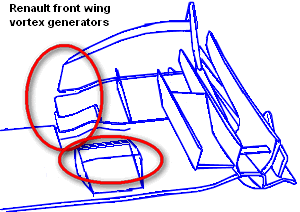 stack of five elements for a small span of the front wings width. But in contrast to other uses of extra slots in the front wing, this is not to create a section producing high downforce. Instead each of these steps is designed to create tip vortices to drive airflow along the axis 250mm from centerline (so called axis Y250).
stack of five elements for a small span of the front wings width. But in contrast to other uses of extra slots in the front wing, this is not to create a section producing high downforce. Instead each of these steps is designed to create tip vortices to drive airflow along the axis 250mm from centerline (so called axis Y250).
Teams tend to create the greater amount of downforce towards the front outer wing tips. This pressure distribution reduces the load on the inboard end of the wing, in order to better manage the airflow headed below the car. However what teams do want to do is to use the relatively undisturbed airflow along this axis and use it to drive airflow over the centre of the car. A steeper wing towards the neutral 50cm centre section of wing would produce unwanted turbulence and rob the airflow of energy. The bodywork rules do allow for some creativity with the vanes and other bodywork allowed along the edge of the monocoque. Known as the Y250 vortex, as most of the aerodynamic effects are created along a line starting 25cm from the cars centreline (Y= lateral axes, 250mm). Components that work along this axis include the front wing mounting pillars, any under-nose vanes, the T-Tray splitter and the intersection of the front wing and the neutral centre section. Flow structures along this axis drive airflow under the floor towards the diffuser and around the sidepod undercuts. Each with the aim to create more efficient rear downforce.
If Renault created a single front wing element with the same angle of attack, a single large vortex would have been produced. This would be far more powerful and pointed outwards a smaller area downstream on the car. By splitting the wing into smaller separate sections, several smaller vortices are created. These are each of lower energy and are spread over wider area. Use of vortices are to shape and alter flow over other areas of the car. Vortices are extremely high energy structures. Vortices travel down the sides of the car and act as a barrier. If this vortex generators are positioned correctly, these vortices keep high-pressure air around the car from entering the low-pressure underbody region, thus maintaining more downforce. Perhaps this softer Renault approach creates less sensitivity as the cars attitude changes.
Some more pictures of 2010 cars front wing endplate:
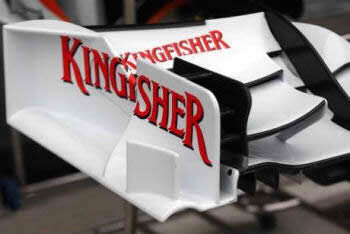
Force India
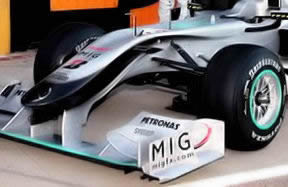
Mercedes GP F1 racer
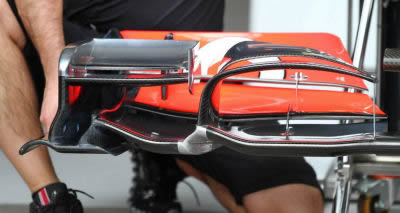
McLaren endplate in the middle of season 2011, artwork
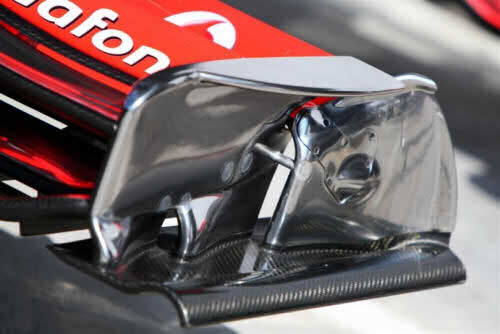
McLaren endplate in the middle of season 2012, artwork
As we can see, front wing development is not primarily about adding front downforce, but about cleaning up flow to the rest of the car and crucially, adding stability when the front wheels are turning through a corner. These tiny details on the front wing are working for that and it seems to be working good.






